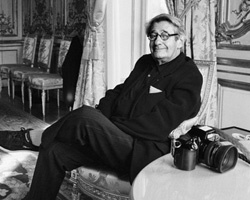
Helmut Newton
2004 Honoree / Special Tribute
Helmut Newton fundamentally changed the terms of the fashion image by bringing a unique mix of style, sex, and theater to fashion photography. However, he was much more than a fashion photographer, as his images of beautiful women, exotic locations and surreal scenes also conveyed an almost cinematic talent. Never conventional, he was awarded the “Grand Prix National” for his photography, as well as being dubbed in some circles “The Prince of Porn.” Newton remarked, “I am superficial, my images aren’t deep. Good taste is the anti-fashion, the anti-photo, the anti-woman, the anti-eroticism. Vulgarity is life, is fun, the desire for extreme reactions.”
Born in Berlin in 1920 to a wealthy family, Newton had no interest in school and was eventually expelled for being a hopelessly lazy pupil whose only interests were swimming, girls, and photography. At the age of twelve, he bought his first camera and later was apprenticed to the Berlin photographer Yva for two years. When he was 15, Newton told his father that he wanted to be a photographer. His father told him: “My boy, you’ll end up in the gutter. All you think of is girls and photos.”
His father proved to be both right and wrong. Newton was, indeed, obsessed with photography — he proposed to his wife with the words, “My work will always come first” — and while women dominated his work, Newton was a long way from the gutter. Not only did he emerge as one of the most popular and highest paid photographers of his time, but he became a celebrity in his own right. His photos have been so widely circulated in books, that they, and their creator, have become contemporary icons.
With the rise of the Nazi party, Newton fled Germany in 1938. He originally went to Singapore and worked as a photojournalist for the Singapore Straits Times. After a few weeks, he moved to Australia and enlisted with the Allied forces. After the war, he opened a small studio in Melbourne, where he met his wife, June Browne, who later became a photographer in her own right, working under the name of Alice Springs.
The turning point in Newton’s career came when he began contributing fashion photos to French Vogue in 1963, with which he maintained a close relationship to for a quarter of a century. His work epitomized the 1960s breakdown of sexual boundaries. In this context, Newton was free to explore obsessions: sado-masochism, lesbianism, pornography, violence and prostitution. His iconic images and unique style have been wildly imitated in every medium from advertising and fashion photography to music videos. Although Newton’s work seem almost tame by today’s standards, they were extremely provocative for his original audience.
Though primarily a fashion photographer, he also photographed celebrity portraits, and had various advertising clients, including Walter Steiger, Swarovski, Absolut and Allied Domecq.
He published more than a dozen books, including White Women (1976), and his definitive Big Nudes (1982). Represented in the permanent collections of the Bibliotheque Nationale in Paris, the Museum of Modern Art, and the George Eastman House in New York, Newton was also honored with an Infinity Award by the International Center of Photography Award in 2000.
Helmut Newton died January 23, 2004, in Hollywood at the age of 83, leaving behind a highly influential legacy in the world of contemporary photography. We honor him tonight as a truly innovative artist.
